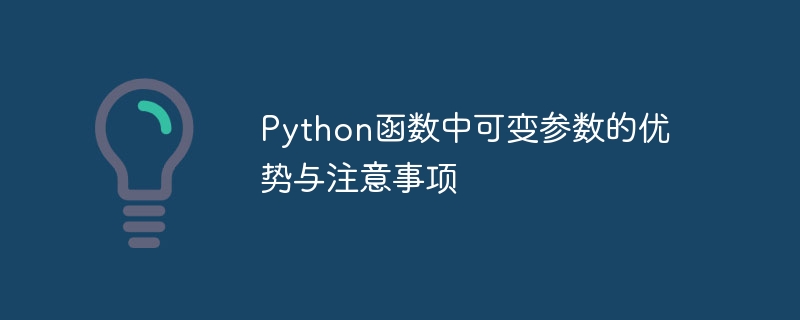Home >Backend Development >Python Tutorial >Advantages and considerations of variable parameters in Python functions
Advantages and considerations of variable parameters in Python functions
- 王林Original
- 2024-02-03 08:52:05841browse

Advantages and precautions of variable parameters in Python functions
With the continuous development of Python, it provides many convenient and powerful function features, one of which It's a variable parameter. Variable parameters allow us to pass in any number of parameters when calling a function, which greatly improves the flexibility and reusability of the program. This article will explore the advantages of variable parameters and compare them with traditional fixed parameters. We'll also provide some notes and code examples.
1. Advantages of variable parameters
- Flexibility and reusability
Using variable parameters, the function can accept any number of parameters, and There is no need to declare a fixed number of parameters in the function definition. This makes the use of functions more flexible. For example, we can write a sum function that calculates the sum of any number of numbers with a variable argument.
def sum_numbers(*numbers):
result = 0
for num in numbers:
result += num
return result
print(sum_numbers(1, 2, 3, 4, 5)) # 输出15
print(sum_numbers(10, 20, 30)) # 输出60As you can see, we can pass in any number of parameters, and the function can correctly calculate the sum. This flexibility not only makes the use of functions more convenient, but also improves code reusability.
- Readability and simplicity
Using variable parameters, the code of the function can be more concise and more readable. Compared with traditional fixed parameters, variable parameters can reduce repeated code. For example, we can write a function that prints a person's information with a different number of parameters.
def print_info(*args):
for arg in args:
print(arg)
print_info("Tom")
print_info("Tom", 25)
print_info("Tom", 25, "Male")By using variable parameters, we can pass in any number of parameters when calling the function without having to define different numbers of formal parameters. This makes the function code more concise and also increases the readability of the code.
2. Notes on variable parameters
- Variable parameters must be placed at the end of the parameter list
In function definitions, variable parameters The parameter must be the last parameter in the parameter list. If there are other arguments after the varargs, Python will not be able to distinguish the variadic boundaries. For example, the following function definition is wrong:
def wrong_func(a, *b, c):
print(a, b, c)- How to pass in variable parameters
When calling a function, we can pass in variable parameters in two ways Variable parameters:
(1) Passing parameters through position
def sum_numbers(*args):
result = 0
for num in args:
result += num
return result
numbers = [1, 2, 3, 4, 5]
print(sum_numbers(*numbers)) # 输出15(2) Passing parameters through keywords
def person_info(**kwargs):
for key, value in kwargs.items():
print(key, value)
person_info(name="Tom", age=25, gender="Male") It should be noted that when passing parameters through keywords, The format of parameter passing should be key=value.
3. Conclusion
Variable parameters are a very useful feature in Python functions, which provide greater flexibility and code reusability. Using variadic parameters, we are able to handle any number of parameters, making the function more versatile in different scenarios. However, when using variadic parameters, we need to observe corresponding precautions to ensure the correctness and readability of the code.
To sum up, the advantage of variable parameters lies in their flexibility and reusability, which can make the use of functions more convenient and the code more concise; at the same time, when we use variable parameters, we need to pay attention to their placement and placement method when passing parameters. Through reasonable use and understanding, variable parameters can greatly improve our code efficiency and development results.
Through the introduction of this article, I believe readers can clearly understand the advantages and precautions of variable parameters, and can flexibly use them in actual projects.
The above is the detailed content of Advantages and considerations of variable parameters in Python functions. For more information, please follow other related articles on the PHP Chinese website!
Related articles
See more- How to Format X-Axis Date Tick Labels for Clarity in Bar Graphs?
- How do I handle POST and GET variables in Python using different web frameworks?
- How to Manage Local and Production Settings in Django?
- How Can I Modify Output Formatting for Pandas Groupby Aggregation with Scientific Notation?
- How Can I Efficiently Iterate Through a Range of Dates in Python?

